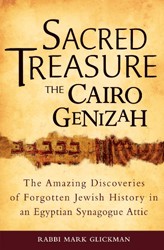A pile of garbage changed how we viewed Jewish history — as documented in Sacred Trash: The Lost and Found World of the Cairo Geniza, the discovery changed how scholars understood countless aspects of Jewish learning and living. Marina Rustow, a Princeton University professor and a MacArthur Fellow, demonstrates that it wasn’t only Jewish culture that was enlightened by the dusty fragments and documents.
Rustow argues over the course of the The Lost Archive: Traces of a Caliphate in a Cairo Synagogue—a sort of encyclopedic detective story — that the lost history of the Fatimid caliphate that established the city of Cairo as a cultural and governmental center can be recreated by reading between the lines. Rustow’s investigation, utilizing — among other tools — the Friedberg Geniza Project, uncovers that roughly 4,000 Arabic documents lay buried underneath the writing of the Jewish documents. Arab petitions, tax receipts, governmental documents and the like were written over by the Jews, who recycled the available material at their disposal for their own ritual, familial, and judicial texts. These constitute the main focus of geniza scholars. Rustow has an enthusiasm for this earlier, non-Jewish, layer of material that includes long samples of Arabic writing styles, and includes turns of phrase that are both literary and academic. When examining a particular scrap, she questions whether the author who had written over an earlier text “scrape[d] it down as an act of theological aggression, of philological philistinism, or of gross material necessity.”
Her description of the dust of Cairo that blankets so much of the city spans four consecutive pages but is enthralling. For example: “If the European fogs are blankets of oblivion, the dust of Cairo is like a memory potion. It gives itself to the city like a mantle and has been doing so generously for centuries, coasting the buildings in a brown patina.” Though a six-hundred page book on medieval scribal practices and textual transmission will be of most interest to specialists — along the way Rustow makes several self-deprecating jokes about how excited she is by the aforementioned tax receipts from the eleventh-century — those seeking to ask important questions about the Jewish-Arab dynamic in medieval times will also find much to glean. As Rustow concludes her deep dive into attempting to piece together from thousands of partial texts the lost world that lies beneath another, “fragments don’t always permit the kind of narrative history that most historians prefer to write — narrative at the scale of human lives. But nor can historians thrive in the airless microcosm of single documents.” By opening up this wider view of the history of the geniza, Rustow restores a surprising, and informative, lost era.
Dr. Stu Halpern is Senior Advisor to the Provost of Yeshiva University. He has edited or coedited 17 books, including Torah and Western Thought: Intellectual Portraits of Orthodoxy and Modernity and Books of the People: Revisiting Classic Works of Jewish Thought, and has lectured in synagogues, Hillels and adult Jewish educational settings across the U.S.





